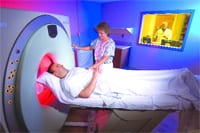Baystate Mary Lane Introduces 16-slice CT Scan
WARE — Baystate Mary Lane Hospital recently installed a new 16-slice CT Scan in its Radiology Department.
The CT (computed tomography) scan has become one of the most important tools to diagnose head and spine injuries, lung and liver disease, cancer, tumors, blood clots, internal bleeding, and other diseases and illnesses.
“Our new 16-slice CT spiral scanner does two very important things that benefit the patient,” said Dr. Gerardo Paulino, medical director of Radiology and Imaging Services. “One is it cuts the average CT exam time, which means that each patient undergoing a CT scan will experience a shorter exam. It also does a better job in the diagnosis of diseases for patients without the need for surgical exploratory procedures, thanks to enhancement in images and clarity of exams.”
The 16-multi-slice CT scanner works much like traditional CT scanning machines, but with improved speed and image quality. Procedures that used to take 10 minutes or more to perform now take about 60 seconds.
The faster scanning is especially beneficial in emergency situations and in treating critically ill or elderly patients. The new scanner takes 16 pictures, or slices, of the body per revolution, up to four times the number taken by previous-generation scanners. The high number of “slices” results in detail so fine that technologists can now produce images of the body that show detail such as wrinkles on a patient’s skin. All this takes place in multicolored 3-D images.
“It is state-of-the-art technology in CT scanning. The images are sharper, and the information it can provide for physicians is very detailed,” Paulino said. “Our new CT scan provides clearer, better, 3-D pictures of anatomical structures like aneurysms, tumors, and infections. When our radiologists can see what’s inside better, they make more accurate diagnoses.
“In part to its’ speed and sensitivity, the 16-slice CT is designed to secure detailed images of patients who may not be able to be imaged in MRI machines, due to metal or pacemakers,” Paulino added. “Having this kind of advanced technology right here improves the quality of care patients can receive in their own community close to home.”



Comments are closed.